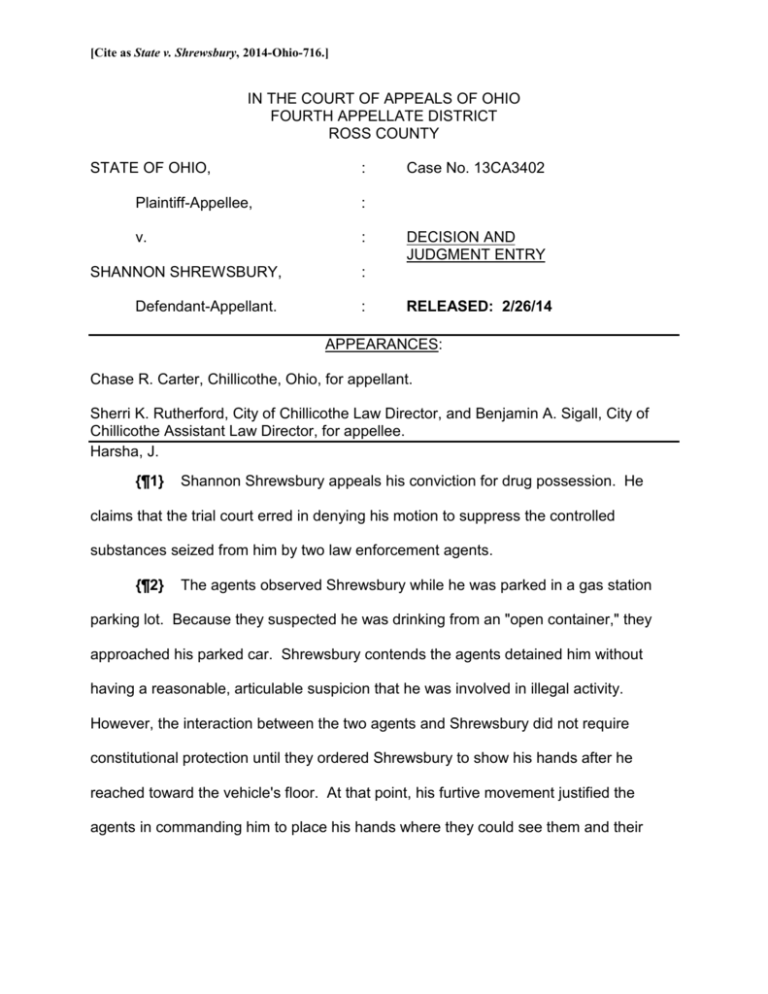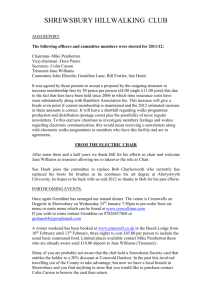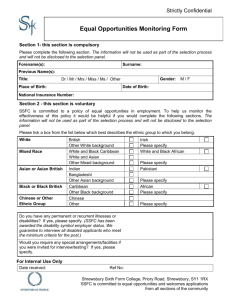State v. Shrewsbury
advertisement

[Cite as State v. Shrewsbury, 2014-Ohio-716.]
IN THE COURT OF APPEALS OF OHIO
FOURTH APPELLATE DISTRICT
ROSS COUNTY
STATE OF OHIO,
:
Plaintiff-Appellee,
:
v.
:
SHANNON SHREWSBURY,
Defendant-Appellant.
Case No. 13CA3402
DECISION AND
JUDGMENT ENTRY
:
:
RELEASED: 2/26/14
APPEARANCES:
Chase R. Carter, Chillicothe, Ohio, for appellant.
Sherri K. Rutherford, City of Chillicothe Law Director, and Benjamin A. Sigall, City of
Chillicothe Assistant Law Director, for appellee.
Harsha, J.
{¶1}
Shannon Shrewsbury appeals his conviction for drug possession. He
claims that the trial court erred in denying his motion to suppress the controlled
substances seized from him by two law enforcement agents.
{¶2}
The agents observed Shrewsbury while he was parked in a gas station
parking lot. Because they suspected he was drinking from an "open container," they
approached his parked car. Shrewsbury contends the agents detained him without
having a reasonable, articulable suspicion that he was involved in illegal activity.
However, the interaction between the two agents and Shrewsbury did not require
constitutional protection until they ordered Shrewsbury to show his hands after he
reached toward the vehicle's floor. At that point, his furtive movement justified the
agents in commanding him to place his hands where they could see them and their
Ross App. No. 13CA3402
2
contents. Because this seizure was objectively reasonable, the trial court correctly
denied his motion to suppress, and we affirm Shrewsbury’s conviction and sentence.
I. FACTS
{¶3}
Agents Donald Germany and Collette Shannon of the Ohio Department of
Public Safety investigate violations of Ohio's Liquor Control Laws and certain provisions
of the criminal code. Agent Shannon had over five years of experience in that capacity
and acted as a field training officer for Agent Germany during this incident. Agent
Germany had been on the job for less than a year, but had previously been a police
detective for four years, including working narcotics investigations as an undercover
officer, witnessing and participating in hand-to-hand drug transactions. As part of the
agents’ duties, they investigate violations of liquor laws on the premises of businesses
that have liquor permits.
{¶4}
One evening, Agents Germany and Shannon, who were in plain clothes,
drove to the Speedway gas station on the corner of Bridge and Main streets in
Chillicothe and parked in front of a gas pump. Agent Germany observed Shrewsbury
exit a red two-door car parked between the air pump and the gas pumps and approach
an occupant in a pickup truck, with whom he seemed to quickly exchange something
hand to hand. Based on his training and experience, Agent Germany suspected it
might be a drug transaction because of the nature of the exchange and how fast it took
place. Agent Shannon observed Shrewsbury walking up and talking to someone in the
truck, but because she was busy parking their car, she did not observe the hand-tohand transaction.
Ross App. No. 13CA3402
{¶5}
3
Shrewsbury then returned to the driver’s seat of the parked car and took a
drink from a gold or silver metallic-colored can. After observing the appearance of the
can, the agents believed that Shrewsbury was drinking either a beer or another
alcoholic beverage. According to Agent Germany, gold and silver cans are more
commonly beer or alcoholic beverage cans. Based on her past experience with similar
looking cans, Agent Shannon thought that Shrewsbury was drinking from a gold Miller
beer can.
{¶6}
Based on their observations, the agents believed that Shrewsbury may
have been violating the open-container law, and they decided to approach the parked
car to determine whether the can contained alcohol. Agent Germany approached the
driver’s side of the car, and Agent Shannon approached the passenger side. There
were other occupants in the car who were drinking from a metallic looking can. When
the agents identified themselves as officers and produced their badges, Shrewsbury
reached down towards the floor on the driver’s side of the car. The agents immediately
ordered him to place his hands on the steering wheel because they were concerned
that he was reaching for a weapon. Shrewsbury opened his hand and revealed a clear
plastic container with pills in it. Ultimately, the agents realized that the can that
Shrewsbury had been drinking from did not contain alcohol.
{¶7}
The agents ordered Shrewsbury to exit the car, and he gave them
permission to search the vehicle. Shrewsbury admitted that he had paid $100 for five
pills of Suboxone, which is a brand name for buprenorphine. See State v. Altman, 7th
Dist. Columbiana No. 12CO42, 2013-Ohio-5883, ¶ 8. A search of Shrewsbury
uncovered a metal container with more Suboxone pills in it. The agents arrested
Ross App. No. 13CA3402
4
Shrewsbury and charged him with one count of possession of drugs in violation of R.C.
2925.11(A), a misdemeanor of the first degree.
{¶8}
After Shrewsbury filed a motion to suppress all evidence taken from him,
the Chillicothe Municipal Court held a hearing where the only witnesses who testified
were the agents. The parties submitted posthearing briefs, and the trial court issued a
decision denying the motion. The trial court determined that the state had presented
sufficient facts to establish that the agents had a reasonable suspicion that Shrewsbury
had committed or was committing a crime and that the agents were justified in
investigating the presence of open containers in potential violation of Ohio liquor laws.
The court reasoned when Shrewsbury made furtive movements, the officer's safely
justified their command to disclose what he held in his hands.
{¶9}
Shrewsbury changed his plea to no contest, and the trial court convicted
him of drug possession and sentenced him. This appeal ensued.
II. ASSIGNMENT OF ERROR
{¶10} Shrewsbury assigns the following error for our review:
The trial court erred in denying Mr. Shrewsbury’s Motion to Suppress as
the Agents possessed no reasonable, articulable facts necessary for a
warrantless search under Terry v. Ohio.
III. STANDARD OF REVIEW
{¶11} Appellate review of a trial court’s decision on a motion to suppress raises
a mixed question of law and fact. State v. Hobbs, 133 Ohio St.3d 43, 2012-Ohio-3886,
975 N.E.2d 965, ¶ 6. Because the trial court acts as the trier of fact in suppression
hearings and is in the best position to resolve factual issues and evaluate the credibility
of witnesses, an appellate court must accept the trial court’s findings of fact if they are
Ross App. No. 13CA3402
5
supported by competent, credible evidence. State v. Burnside, 100 Ohio St.3d 152,
2003-Ohio-5372, 797 N.E.2d 71, ¶ 8. Accepting these facts as true, we must then
“independently determine, without deference to the conclusion of the trial court, whether
the facts satisfy the applicable legal standard.” Hobbs at ¶ 8, citing Burnside at ¶ 8.
{¶12} Shrewsbury does not attack the trial court’s factual findings in its decision
denying his motion to suppress. Therefore, the dispositive issue in this case is whether
these facts satisfied the applicable legal standard and supported the trial court’s
decision to deny the motion.
IV. LAW AND ANALYSIS
Search and Seizure
{¶13} In his sole assignment of error, Shrewsbury contends that the trial court
erred in denying his motion to suppress because the agents possessed no reasonable,
articulable facts to support the warrantless stop and search.1
{¶14} “The Fourth Amendment to the United States Constitution and the Ohio
Constitution, Article I, Section 14, prohibit unreasonable searches and seizures.” State
v. Emerson, 134 Ohio St.3d 191, 2012-Ohio-5047, 981 N.E.2d 787, ¶ 15. This
constitutional guarantee is protected by the exclusionary rule, which mandates the
exclusion of the evidence obtained from the unreasonable search and seizure at trial.
Id.
{¶15} The Supreme Court of the United States recognizes three types of policecitizen interactions, only the last two of which implicate the Fourth Amendment
constitutional prohibition against unreasonable searches and seizures: (1) a
1
In his statement of the Assignment of Error, Shrewsbury contests the "stop by plain clothes officers…(.)"
In his Argument and Law, he phrases the assignment of error as involving an unjustified "warrantless
search." In an abundance of caution, we address both.
Ross App. No. 13CA3402
6
consensual encounter, which requires no objective suspicion; (2) a brief, investigatory
stop or detention, which must be supported by a reasonable, articulable suspicion of
criminal activity; and (3) an arrest, which must be supported by probable cause. United
States v. Williams, 525 Fed.Appx. 330, 332 (6th Cir.2013); Florida v. Royer, 460 U.S.
491, 501-507, 103 S.Ct. 1319, 75 L.Ed.2d 229 (1983); United States v. Mendenhall, 446
U.S. 544, 553, 100 S.Ct. 553, 100 S.Ct. 1870, 64 L.Ed.2d 497 (1980).
{¶16} A consensual encounter occurs when an officer approaches a person in a
public place, talks with the person, requests information, and the person is free not to
answer and walk away. State v. Jones, 4th Dist. Washington No. 11CA13, 2012-Ohio1523, ¶ 9. “' * * * The mere approach and questioning of persons seated within parked
vehicles does not constitute a seizure * * *,’ i.e. it is a consensual encounter.” Id.,
quoting State v. Turley, 4th Dist. Lawrence No. 96CA20, 1997 WL 111761, at *2, citing
3 LaFave, Search and Seizure, Section 9.2(b), 408-409 and 415-416 (2 Ed.1987); State
v. Weimer, 11th Dist. Lake No. 2013-L-008, 2013-Ohio-5651, ¶ 40 (citing the wellsettled principle that an encounter may be consensual when a police officer approaches
and questions individuals in or near a parked car).
{¶17} The trial court determined that the agents had a reasonable suspicion to
investigate the existence of an open-container violation and that Shrewsbury’s
movements towards the floorboard area caused concern for their safety. Because we
conclude that the agents' approach of Shrewsbury's parked car did not implicate the
Fourth Amendment, we need not consider whether they had a reasonable articulable
suspicion for doing so.2
2
As an aside, we are not critical of the trial court's conclusion and would in fact reach the same
conclusion were we required to address the issue.
Ross App. No. 13CA3402
7
{¶18} The agents’ actions did not impact Shrewsbury’s constitutional right to be
free from unreasonable searches and seizures up to and including the time when they
approached the parked car where he was sitting and identified themselves as police
officers. The agents did not stop the vehicle in which Shrewsbury sat; it was already
parked in a public place. And when they identified themselves as officers, they had not
yet questioned him or the occupants of the car.
{¶19} The agents decided to approach the vehicle to determine if the open can
that Shrewsbury was drinking from was a beer can. Because the officers were able to
do that by looking into the car, which was parked in a public place, no unreasonable
search or seizure occurred, i.e. no Fourth Amendment interest was involved. State v.
Bradford, 4th Dist. Adams No. 09CA880, 2010-Ohio-1784, ¶ 35 (“The open view
doctrine applies where an officer views an object that is not subject to a reasonable
expectation of privacy. No search occurs because the owner of the object has
voluntarily exposed it to public view”); Katz, Ohio Arrest, Search and Seizure, Section
14:5, 349 (2013) (distinguishing “open view” from “plain view” and noting that a “police
officer who looks into the car window sees the contents in open view”). In sum, there is
no reasonable expectation of privacy in places and objects that are open for the public
to see. Absent that expectation, there is no Fourth Amendment protection.
{¶20} When the agents approached the car and identified themselves,
Shrewsbury immediately reached down towards the floorboard of the car. The agents
were concerned that he was reaching for a weapon and ordered that he place his hands
on the steering wheel. In effect, Shrewsbury’s furtive movement in reaction to the
agents’ identification of themselves escalated the matter from a consensual encounter
Ross App. No. 13CA3402
8
to an investigatory stop. See Jones, 2012-Ohio-1523, at ¶ 9 (the constitutional
guarantees concerning seizures are implicated if the police officer has by either physical
force or show of authority restrained the person’s liberty so that a reasonable person
would not feel free to decline the officer’s requests or otherwise terminate the
encounter).
{¶21} Shrewsbury argues Agent Germany’s testimony that he had witnessed
Shrewsbury engage in a suspected drug transaction did not provide the specific,
articulable facts to support an investigative stop. Shrewsbury’s argument is irrelevant,
however, because the seizure did occur in response to that suspicion. It occurred in
response to a perceived risk of harm to agents.
{¶22} When the agents approached and identified themselves to Shrewsbury,
they did not initiate an investigatory stop. It was Shrewsbury's conduct of immediately
reaching towards the floorboard below him that necessitated the agents’ order to place
his hands on the steering wheel, i.e. to initiate a seizure. Contrary to Shrewsbury's
assertion, this furtive movement was the impetus for the seizure; it did not occur after
the seizure as he claims in his brief.
{¶23} When the agents ordered Shrewsbury to raise his hands and disclose
what was in them, they implicated his Fourth Amendment protection. Thus, we must
now address whether the limited seizure of his person was reasonable. An officer may
conduct a limited search of a person for weapons if the officer has reasonable concern
for personal or public safety. See generally Katz, Ohio Arrest, Search and Seizure, at
§16:1. Society recognizes the need to protect officers who are engaged in
Ross App. No. 13CA3402
9
investigations. Id., citing State v. White, 110 Ohio App.3d 347, 674 N.E.2d 405 (4th
Dist. 1996).
{¶24} Normally, persons suspected of open container violations are not within
that class of offenses that the Supreme Court of Ohio has indicated justify a virtually
automatic right to frisk, such as drug offenses. However, the totality of the
circumstances here involves Shrewsbury's furtive movement toward the floor area of the
car and the agents' explicit concern for their safety. When issues of an officer's safety
arise and are supported by articulable facts, courts should not scrutinize the claim too
critically, nor should they second guess an officer in a close case. Katz, Ohio Arrest,
Search and Seizure, at §16.1.
{¶25} Here the agents both indicated Shrewsbury immediately reached under
the seat area when they disclosed their identity. Both testified they were concerned he
may have been reaching for a weapon. Accordingly, we conclude the agents' order
instructing Shrewsbury to place his hands on the steering wheel and to disclose what he
held was objectively reasonable in nature and scope.
{¶26} Under the totality of the circumstances, a reasonable officer could believe
that Shrewsbury may have been reaching for a weapon, i.e., the agents were not acting
on a mere hunch. The fact that the container Shrewsbury had been drinking from was
later determined not to contain alcohol does not require a different conclusion. The
focus is instead on what the agents knew at the time of the investigatory stop. See,
e.g., State v. Cox, 5th Dist. Knox No. 10-CA-0016, 2011-Ohio-1316, ¶ 22-23 (affirming
denial of motion to suppress evidence seized in an investigatory stop based on
trooper’s false impression of violation of R.C. 4511.66); compare Bowling Green v.
Ross App. No. 13CA3402
10
Godwin, 110 Ohio St.3d 58, 2006-Ohio-3563, 850 N.E.2d 698, ¶ 15 (fact that defendant
could not be convicted of failure to obey a traffic-control device is not determinative of
whether the officer acted reasonably in stopping and citing him for that offense”).
{¶27} Immediately upon the initiation the stop, Shrewsbury raised his hands and
revealed the container with pills, which justified the subsequent search, questioning,
and arrest.3 Therefore, the trial court did not err in denying the motion to suppress.
V. CONCLUSION
{¶28} The trial court properly concluded that based on the totality of
circumstances, the law enforcement agents had a reasonable suspicion, based on
specific, articulable facts for their investigatory stop of Shrewsbury. Having overruled
his sole assignment of error, we affirm the judgment of the trial court.
JUDGMENT AFFIRMED.
3
Because Shrewsbury does not contest whether it was immediately apparent the container held
contraband, we do not address that issue.
Ross App. No. 13CA3402
11
JUDGMENT ENTRY
It is ordered that the JUDGMENT IS AFFIRMED and that Appellant shall pay the
costs.
The Court finds there were reasonable grounds for this appeal.
It is ordered that a special mandate issue out of this Court directing the
Chillicothe Municipal Court to carry this judgment into execution.
IF A STAY OF EXECUTION OF SENTENCE AND RELEASE UPON BAIL HAS
BEEN PREVIOUSLY GRANTED BY THE TRIAL COURT OR THIS COURT, it is
temporarily continued for a period not to exceed sixty days upon the bail previously
posted. The purpose of a continued stay is to allow Appellant to file with the Supreme
Court of Ohio an application for a stay during the pendency of proceedings in that court.
If a stay is continued by this entry, it will terminate at the earlier of the expiration of the
sixty day period, or the failure of the Appellant to file a notice of appeal with the
Supreme Court of Ohio in the forty-five day appeal period pursuant to Rule II, Sec. 2 of
the Rules of Practice of the Supreme Court of Ohio. Additionally, if the Supreme Court
of Ohio dismisses the appeal prior to expiration of sixty days, the stay will terminate as
of the date of such dismissal.
A certified copy of this entry shall constitute the mandate pursuant to Rule 27 of
the Rules of Appellate Procedure.
McFarland, J. & Hoover, J.: Concur in Judgment and Opinion.
For the Court
BY: ________________________
William H. Harsha, Judge
NOTICE TO COUNSEL
Pursuant to Local Rule No. 14, this document constitutes a final judgment
entry and the time period for further appeal commences from the date of filing
with the clerk.





